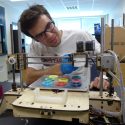100-Hour Challenge winners represent campus creativity, ingenuity
Where else on campus would someone find high fashion, conservation initiatives, die-hard partiers and fish in the same competition?
This year’s third annual 100-Hour Wiscontrepreneur Challenge attracted a record of nearly 200 students and 63 entries, compared to last year’s 17, during the four-day span of the competition.
The challenge, sponsored by the UW–Madison Office of Corporate Relations and supported by a grant from the Kauffman Foundation, invited students to make an entrepreneurial product between Feb. 18-22 out of $15 worth of surplus material purchased from a Surplus With a Purpose (SWAP) shop open in the basement of Sellery Hall for the first two days of the challenge.
On Feb. 22, participating teams and individuals posted a digital photo set, electronic slide set, video or other electronic communication of their product here.
Douglas Bradley, assistant director of marketing and communications in the Office of Corporate Relations, announced the winners of the challenge today (March 2) in faculty associate Jeanan Yasiri‘s Entrepreneurialism in Society class.
All of Yasiri’s 130 students participated in the challenge and produced 31 projects, comprising nearly half of the total entries received.
The judges awarded $300 to three projects in the categories of “Most Creative,” “Most Social Value Generated” and “Most Value Generated.” The “People’s Choice” award of $100 was given to the team whose project was viewed online the most.
Sophomore Jessica Cabrera’s “Madison Style” won the category “Most Creative.” Cabrera created a dress out of air filters, yellow wire, vacuum filters and styrofoam peanuts.
“I love retail and I love ‘Project Runway,'” she says. “I was inspired just by some air filters.”
Cabrera, of Plymouth, Minn., is also one of Yasiri’s students.
Bradley says the judges were impressed with Cabrera’s vision. “There was a high degree of skill, creativity and artistry displayed in this unique creation,” he says.
The award for “Most Social Value Generated” went to “Aqua Treat” by Robert Chumanov and Peter Kuhn. Chumanov and Kuhn created a unique water filter that simultaneously creates a chemical additive necessary for sewage treatment out of several SWAP materials including a cordless Swiffer vacuum cleaner, a Plexiglas tube, a spool of wire and a No. 2 pencil.
“What made this one stand out was both its intended goal to improve sanitation and purify drinking water for the world’s poor, but how it also demonstrated an in-depth understanding of the science needed to solve the problem,” Bradley says.
Joe Powell, a freshman from New Berlin, Wis., and Taylor Braun’s “Test Tube Terrarium” won “Most Value Generated.” Out of a ceramic funnel, test tubes, a rack, some paint and an ultraviolet lamp, the team created an indoor terrarium complete with a fish tank and two plants. They also painted the rack red with the UW–Madison “W” on one side and Bucky on the other.
“The ‘Test Tube Terrarium’ is perfect for dorms and could potentially be a big seller with UW students,” Bradley says. “And it doesn’t hurt to have it branded as a UW creation and wrapped in UW humor and zaniness.” Braun is a freshman in kinesiology from Waukesha, Wis.
The “People’s Choice Award” went to sophomore Alex Zielske and freshman Chris Wickler’s “Party Enforcer 3000” with 654 views. The team’s witty Youtube video depicts a “drunk tank” to contain and punish annoying partiers.
“The whole thing was very tongue-in-cheek,” Zielske, of Madison, says. Wickler is from Pewaukee, Wis.
Both Bradley and Yasiri are pleased with the outcome of the challenge.
“Our students are creative, they’re fun-loving, they’re pushing the envelope,” Bradley says. “I think we were all really impressed and overwhelmed with the amount of participation and the kind of rigor and inventiveness our students supplied, and just the depth and breadth of the innovations themselves.”
Yasiri agrees. “I think the students were intimidated at first about the prospect of taking very little and creating something of value from it but what I found less than a week later, 100 hours later, was that they not only could do it but especially working in teams, they learned how to leverage each others intelligence and ideas.”
Bradley points out that nearly half of the projects had to do with conservation.
“When you add the sort of creativity and entrepreneurship and sort of creative problem solving, it makes you very hopeful for what’s going to happen to the economy,” he says.
Bradley also encourages students to utilize the resources on campus, such as the Office of Corporate Relations, Students in Free Enterprise and the Entrepreneurship Association, to pursue further business ventures either with their 100-Hour Challenge projects, or other endeavors they may come up with in the future.
“You’ve flipped some trigger for yourself here that you can do things you maybe hadn’t thought were possible,” he says. “You have hit upon a unique approach to meeting a social need, solving a problem, creating something of value. So don’t stop.”
Tags: business, entrepreneurship, student awards



